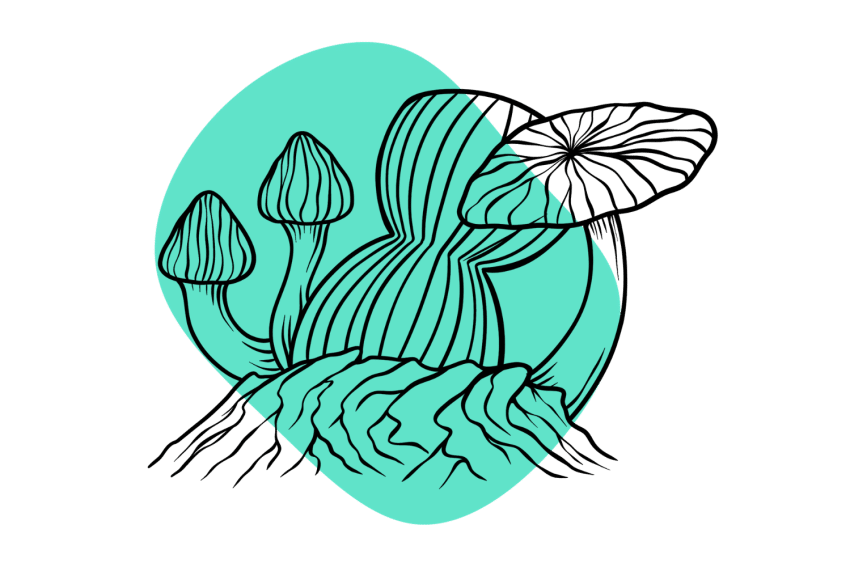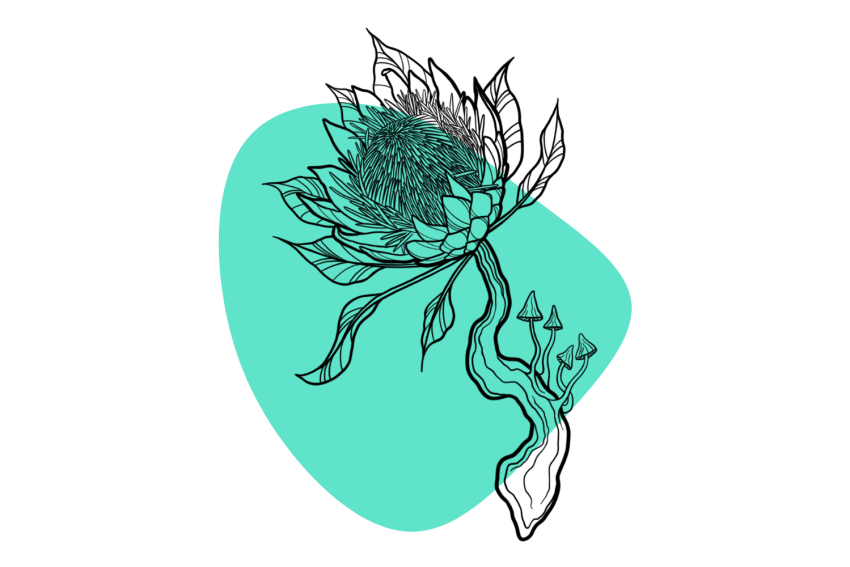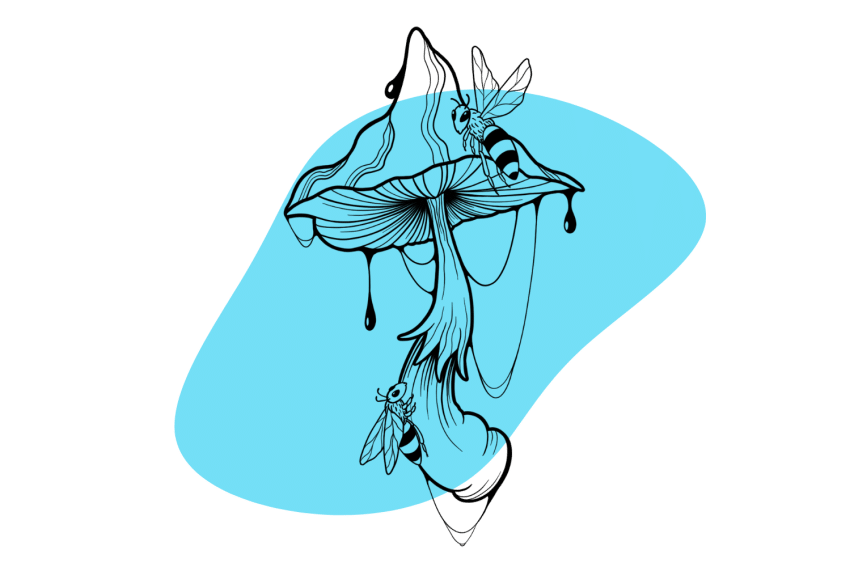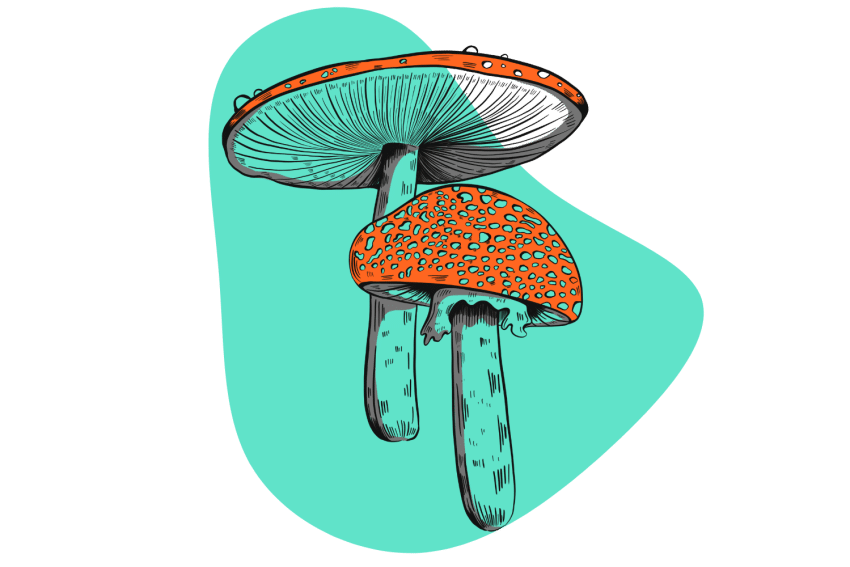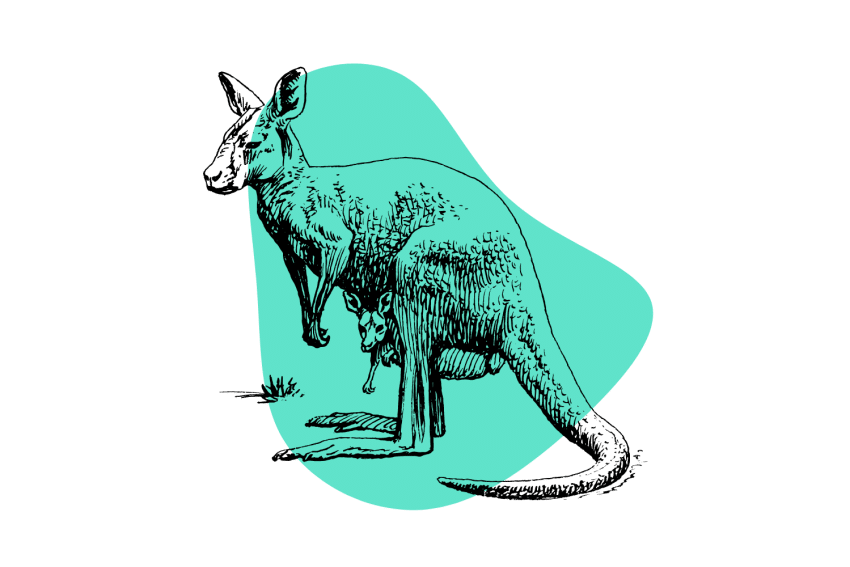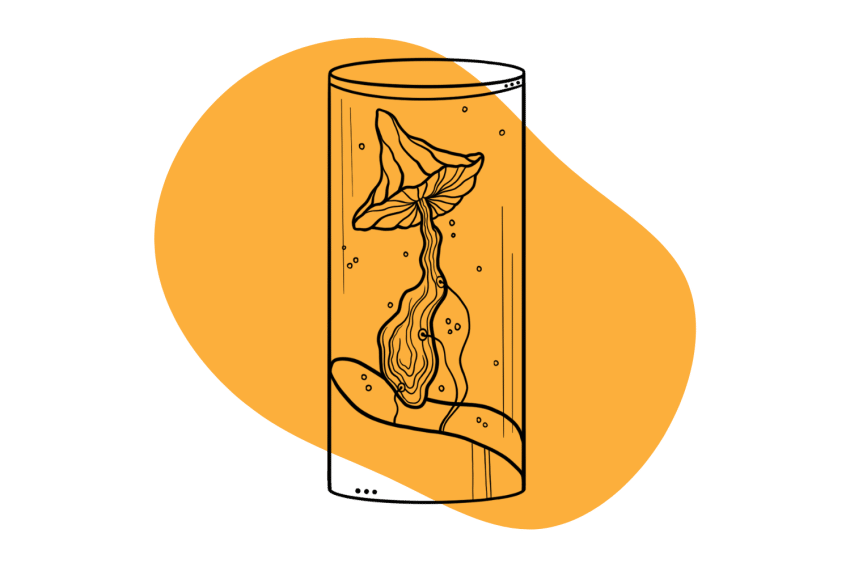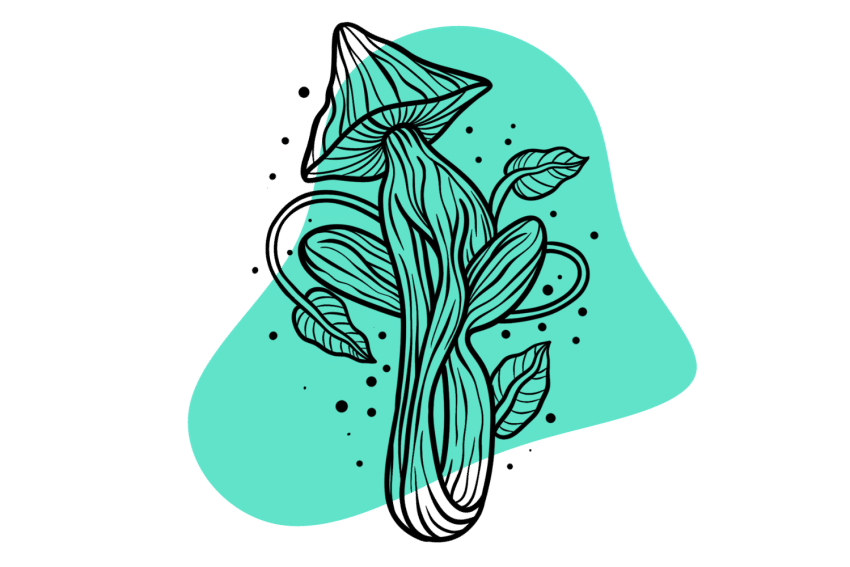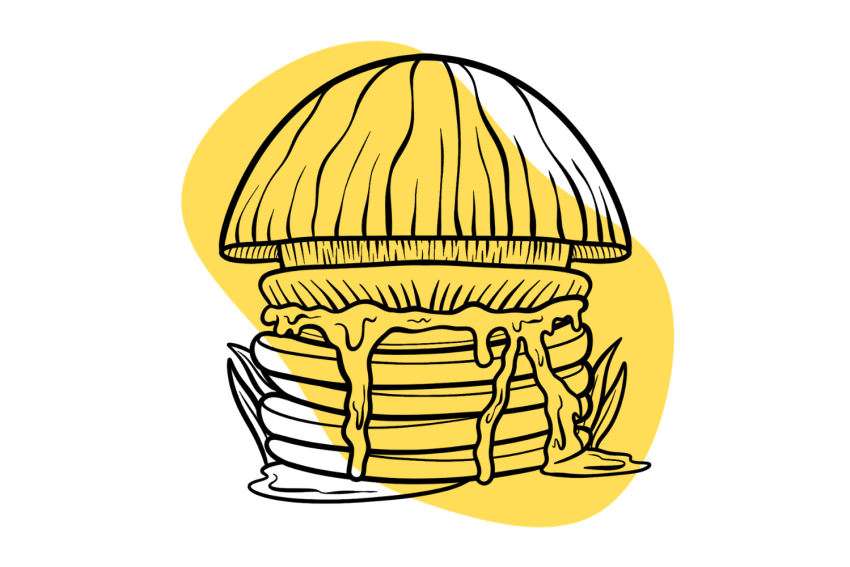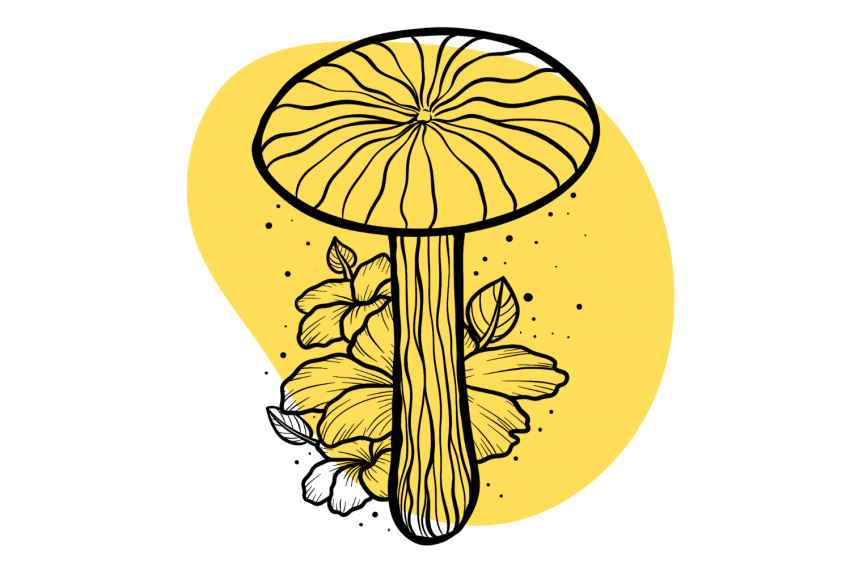Psilocybe weilii: A Rare Psychedelic Shroom from the Southeast
Psilocybe weilii is a magical mushroom often confused with another species — Psilocybe caerulescens. Both share several similarities but are distinct. Here’s what you need to know.
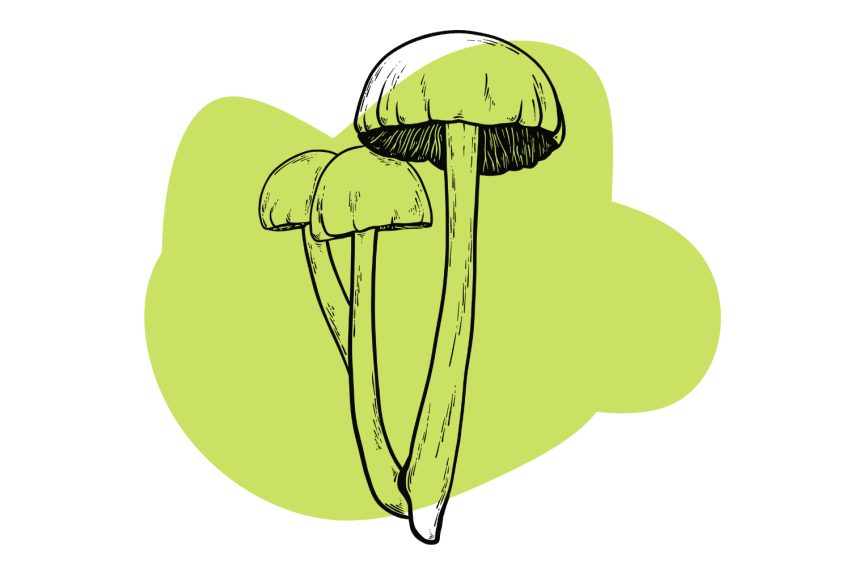
Psilocybe weilii is a psychedelic mushroom species that produces psilocybin and psilocin, among other active tryptamines.
P. weilii isn’t as common as other species in the Psilocybe genus, such as Psilocybe cubensis, nor is it as potent as others, such as Psilocybe azurescens. However, it’s an intriguing species capable of producing “above average” psilocybin and psilocin levels and remarkably high percentages of tryptophan.
Psilocybe weilii mushrooms are medium-sized and sport white stipes and chestnut brown caps — similar to the species it’s often confused with (Psilocybe caerulescens). P. weilii has a limited geographical distribution and has only been discovered in select regions of the southeastern United States.
These magic mushrooms aren’t as easy to cultivate as Psilocybe cubensis (AKA “Cubes”), but a cultivator with some knowledge shouldn’t struggle to produce successful results.
In this article, we’ll cover the Psilocybe weilii species in detail, including its relative potency, dosage information, microdosing potential, identification, where to find them in the wild, cultivation, preparation, legality, and more.
The History of Psilocybe weilii
Psilocybe weilii is a relatively recent discovery, and its history is somewhat limited compared to more extensively researched psychedelic mushroom species such as Psilocybe cubensis, Psilocybe azurescens, and Psilocybe semilanceata.
The species was first discovered and described in 1995 by the legendary mycologist Paul Stamets. The first sample was found growing in southeastern Cherokee County, in northern Georgia, after “Hurricane Opal” swept through the lands.
Stamets named the species in honor of Andrew Weil — a renowned American author and advocate for integrative medicines such as psilocybin.
The earliest written mention of Psilocybe weilii came in 1996, when Paul Stamets described the species in his book “Psilocybin Mushrooms of the World.”
Other than this, no further recorded discoveries have been made. The species is somewhat elusive, and although a few amateur mycologists on forums such as Shroomery have located and described the species, scientific research into its physical and chemical characteristics is lacking.
The Potency & Effects of Psilocybe weilii
Psilocybe weilii mushrooms aren’t as potent as some other mushrooms, but they’re not exactly weak. These shrooms are capable of producing a total tryptamine level of over 0.93% — that’s pretty potent as shrooms go.
This species isn’t well-documented, and there’s very little information on the exact psychedelic tryptamine levels in the mushroom’s flesh. However, we found reports of 0.61% psilocybin, 0.27% psilocin, 0.05% baeocystin, and 0.32% tryptophan.
Unfortunately, there’s no scientific data to back up the tryptamine percentages above. However, the effects of this species correlate with the acclaimed psilocybin and psilocin levels mentioned above.
The effects of Psilocybe weilii mushrooms include:
- Distorted time perception
- Feelings of euphoria
- Seeing and hearing things that aren’t there
- Intensified emotions
- Heightened self-reflection
- Experiencing spiritual or mystical moments
- Shifting perceptions of oneself
- Boosted creativity
- Heightened empathy
- Increased sociability
- Uplifted mood
Related: What’s the Strongest Magic Mushroom Species?
What’s the Dose of Psilocybe weilii Mushrooms?
The potency of Psilocybe weilii is comparable to that of an average potency strain of Psilocybe cubensis. This makes it relatively easy to gauge dosages. If you’ve ever consumed P. cubensis shrooms before, you’ll be able to work out how much dry weight you’ll need to induce the desired effects.
Here are the rough doses in dry weight and milligrams of combined psilocybin/psilocin for Psilocybe weilii:
- Low Dose: 1 gram (10 mg psilocybin/psilocin)
- Medium Dose: 1.75 grams (17.5 mg psilocybin/psilocin)
- High Dose: 3.5 grams (35 mg psilocybin/psilocin)
- Heroic Dose: 5 grams or more (50 mg psilocybin/psilocin)
Magic Mushroom Dosage Calculator
Double-check the potency of the DXM you’re using, and look for the addition of other compounds such as acetaminophen which can cause severe liver-toxic side-effects at this dose.
Microdosing Psilocybe weilii
It’s possible to use Psilocybe weilii for microdosing. This species is relatively average in potency, making it easy to divide the shrooms into sub-perceptual doses.
ith around 0.90% combined psilocybin and psilocin in dried samples, it only takes a small amount for a microdose. This makes it easier for the body to break down and access the tryptamines and puts less strain on the stomach — meaning the individual isn’t as likely to experience stomach discomfort after consumption.
So what is microdosing, and why do people do it?
Microdosing is the act of consuming a sub-perceptual dose of a psychedelic substance, such as the psilocybin in Psilocybe weilii. A microdose of psilocybin is around 1/10th of a psychedelic dose.
A microdose of P. weilii is somewhere in the region of 50 to 100 milligrams (0.5 to 1 gram) of dried mushrooms — this equates to around 5 to 10 milligrams of combined psilocybin and psilocin.
People often microdose with psilocybin to improve focus, boost creativity, stabilize mood, and increase productivity [1]. People with ADHD, depression, anxiety, or stress disorders may benefit from microdosing psilocybin.
It’s important to note that not everyone reacts the same to low doses of psilocybin. What may work for one person may not for another. If you decide to try microdosing Psilocybe weilii or any other psychedelic mushrooms or substances, do so in a controlled environment until you’re aware of how it affects you.
Where Can You Find Psilocybe weilii Mushrooms?
Psilocybe weilii is a rare species of psilocybin mushroom in the wild. It has a limited geographical range and has only been found growing in the southeastern United States.
If you’re keen and have a good eye, you’ll find this species growing in:
- Alabama
- Florida
- Georgia
- South Carolina
Related: Tips For Finding Psychedelic Mushrooms in the Wild
What Habitat Do Psilocybe weilii Mushrooms Grow In?
Psilocybe weilii mushrooms are typically found in open forest areas, growing on disturbed soils with a high percentage of decomposing organic matter. They also grow on wood chips, rotting wood, mulch, and in grassy areas with nutrient-rich soils.
They can be found after periods of rainfall, high winds, landslides, hurricanes, and tornadoes. They fruit from early September through November in the southeastern United States, when the temperatures fall between 7 to 26 °C (45 to 80°F).
How to Identify Psilocybe weilii
Psilocybe weilii mushrooms look remarkably similar to Psilocybe caerulescens mushrooms. However, there are some distinct differences. These small mushrooms may also be confused with other non-psychoactive and potentially toxic fungi species.
You must know how to properly identify this (or any) mushroom species before harvesting and consuming it.
Related: Mushroom Anatomy 101
Here are the defining features of Psilocybe weilii:
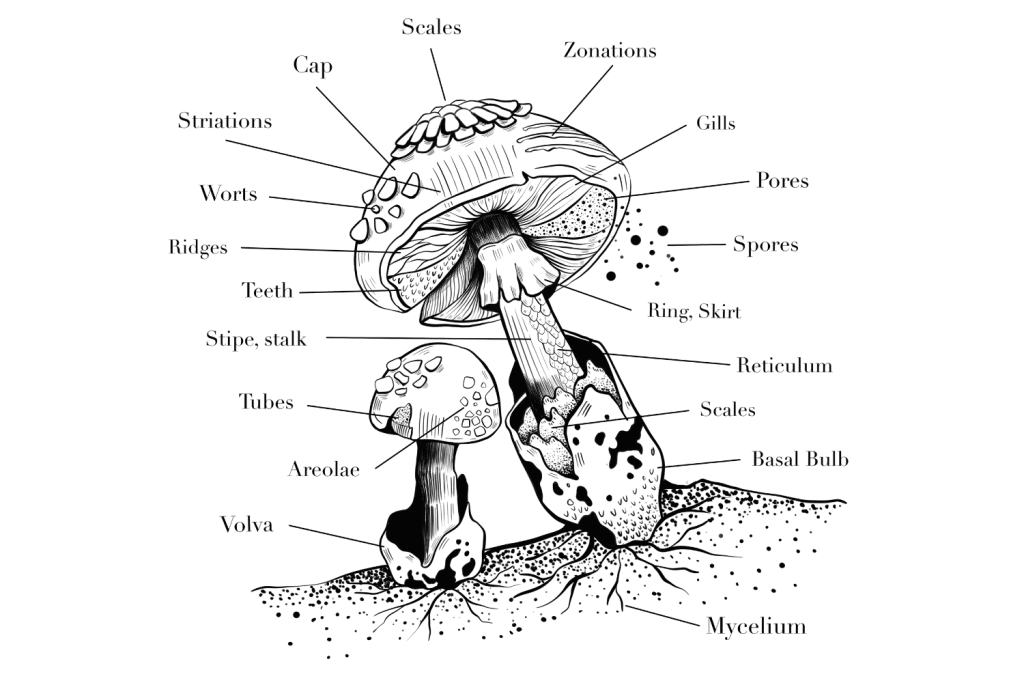
1. Mushroom Caps
The caps of Psilocybe weilii are 2 to 6 cm (0.80 to 2.40 inches) in diameter. They are campanulate (bell-shaped) and somewhat conical (cone-shaped) with an enrolled margin in young shrooms. The caps expand as the mushrooms mature, becoming broadly convex (outwardly rounded) to plane (flat).
They’re a dark chestnut-brown color, often with a darker olive-brown rim. They’re hygrophanous — changing color during different moisture conditions. When dry, they fade to a pallid to light brown color. When damaged, the caps often bruise blue — this indicates the presence of psilocybin.
They have a gelatinous pellicle that can be seen when wet caps are gently split.
2. Gills
The gills of Psilocybe weilii are closely packed with a pallid to light-brown color when young, turning a darker chocolate brown as they mature and begin to sporulate. They are adnate (widely attached to the stem) to sinuate (smoothly notched before running down the stem).
3. Stipe (Stem)
Psilocybe weilii stipes measure 2.5 to 7 cm (1 to 2.80 inches) in length and 4 to 8 millimeters thick. They are mostly equal, swelling close to the basal bulb at the stipe’s base.
Young mushrooms have pure white stems that gradually turn cream to golden brown as they mature. They are covered with white fibrillose (fibrous hair-like follicles) on the lower portion of the stipe and pruinose (a white, powdery substance) on the upper portion. Like the caps, Psilocybe weilii stems bruise blue when damaged or dried.
The partial veil can occasionally leave a fibrillose annular zone (ring around the stipe) below the cap that’s often dusted with purple-black spores. This feature isn’t apparent on all specimens, so it isn’t a key identifier.
4. Spores
The spores of Psilocybe weilii are purple-black or dark violet. They’re sub-ellipsoid from the side view and sub-rhomboid from the face view. The basidia (spore-bearing structures) are always four-spored.
Spore dimensions: 5.5 to 6.5 by 4 to 5 µm (micrometers).
Psilocybe weilii Look-Alikes
To the untrained eye, Psilocybe weilii mushrooms can appear similar to several other species of wild fungi.
Psilocybe weilii has a few potentially lethal “look-alikes,” so it’s crucial to know how to identify these look-alike species and distinguish them from P. weilii before heading out into the field.
Here are a few commonly misidentified species:
1. Psilocybe caerulescens
Psilocybe caerulescens looks almost identical to Psilocybe weilii. The two species are often confused with each other, and many online and physical references list them as the same species.
To the untrained eye, these two species are impossible to distinguish from each other. Psilocybe caerulescens has the same brown caps, adnate gills, and light-colored stems and shares a habitat similar to Psilocybe weilii, growing in a similar geographic range.
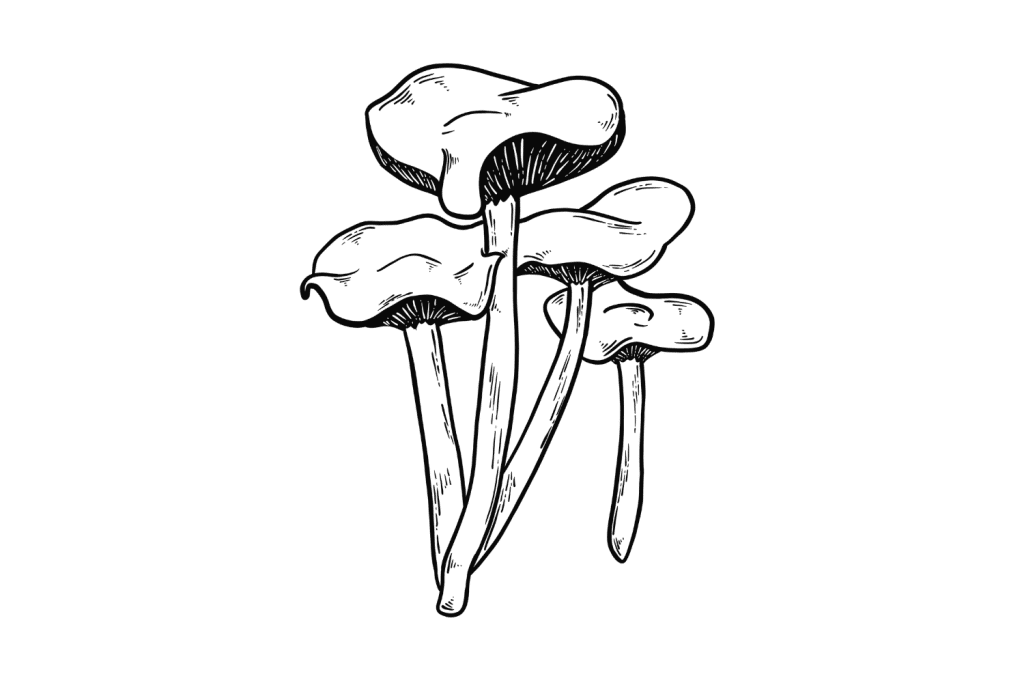
To distinguish P. caerulescens from P. weilii, spore samples may need to be observed under a microscope. Luckily, P. caerulescens is also a psychedelic mushroom that’s safe to consume responsibly.
2. Psilocybe ovoideocystidiata
Psilocybe ovoideocystidiata is another psilocybin mushroom species that shares similarities with Psilocybe weilii. This species has a reddish-brown cap with white to tan-colored stipes. It also shares a similar habitat with P. weilii, preferring woody, disturbed ground.
Although this species can be confused with P. weilii, it’s rarely found in the same parts of the United States. P. ovoideocystidiata has been reported in Ohio, Pennsylvania, and West Virginia, but not usually further south than these states.
3. Gymnopilus junonius
Gymnopilus junonius is also known as “the Laughing Jim” because it can cause hallucinations when ingested. This species does contain psilocybin, but it also produces toxins that can cause stomach upset, nausea, and vomiting if ingested.
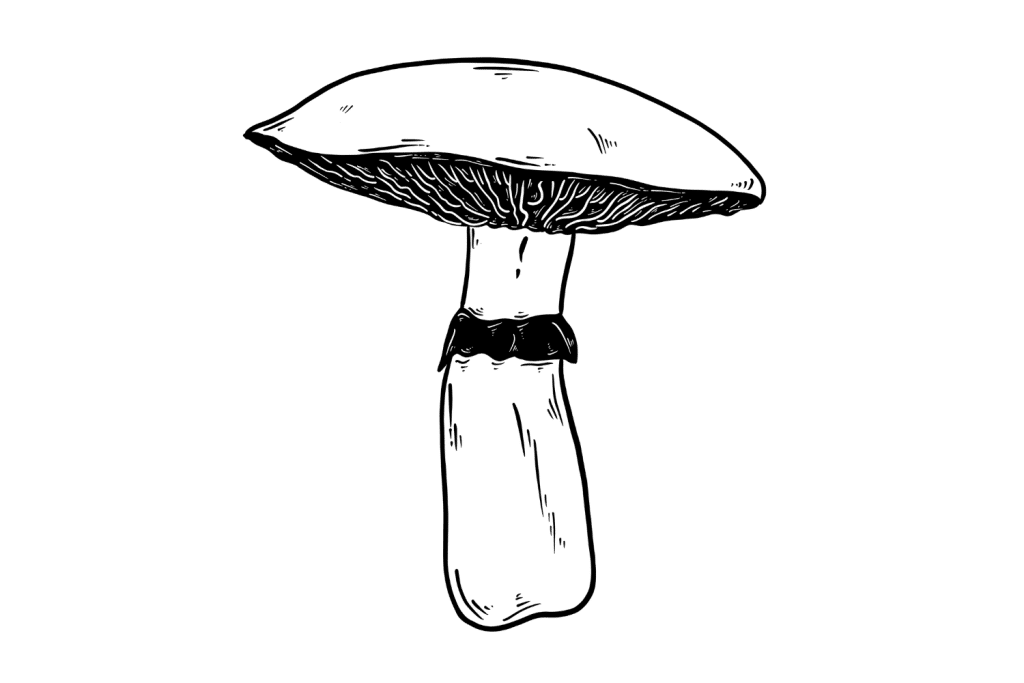
This is a wood-loving species that has a wide geographical range. It does cross into habitats similar to Psilocybe weilii and shares a similar appearance. This species has brown caps and light-colored stems. To the amateur forager, it could be confused with P. weilii.
Gymnopilus junonius has thicker stems and broader caps than P. weilii and usually grows on deadwood rather than woody ground.
4. Galerina marginata
Galerina marginata has earned the common name the “Funeral Bell” for good reason. This species is highly toxic and can cause serious health complications and even death if ingested.
This species is similar to Psilocybe weilii with its similar size, tan-brown caps, and cream-colored stipes, and it grows in a similar geographical range and habitat.
Despite these similarities, it’s relatively easy to distinguish. If you decide to go in search of any Psilocybe species, familiarize yourself with it to ensure you don’t mistake it for something else.
5. Conocybe spp.
Several species of Conocybe share similarities with Psilocybe weilii mushrooms and grow in a similar habitat and region.
Conocybe species often have similar colored caps and stems and a similar size to Psilocybe weilii and other species in the genus. However, they usually have lighter-colored gills and don’t bruise blue when damaged.
It’s a good idea to educate yourself on the Conocybe species in your region before heading into the field to search for P. weilii or any other Psilocybe species.
How To Cultivate Psilocybe weilii Mushrooms
Psilocybe weilii is a relatively easy species to cultivate. Decent yields of medium-sized mushrooms can be produced in an artificial environment using the same techniques used to grow Psilocybe cubensis.
We don’t recommend this species if you’re a beginner, but if you’ve grown Psilocybe mushrooms before, producing high yields of potent mushrooms shouldn’t be too hard.
The simplest way to cultivate P. weilii mushrooms is to utilize a technique known as “PF Tek” — Psilocybe Fanaticus Technique. This cultivation technique requires little in the way of equipment, knowledge, or time.
PF Tek requires the cultivator to sterilize a growing medium in a series of glass mason jars. These jars are then inoculated with Psilocybe weilii spores and left to incubate for a period of two to three weeks until the substrate within has completely colonized with mycelium.
Once colonized, the resulting “mycelium cakes” are removed from the jars and “fruited” in a simple fruiting chamber that provides the correct temperature and humidity for mushroom growth. Mushrooms then begin to appear in “flushes” over a period of weeks. As the mushrooms mature, they’re harvested, dried, and stored.
If you want to learn how to grow Psilocybe weilii mushrooms using PF Tek, follow our guide: How to Grow Magic Mushrooms: The Easy Way
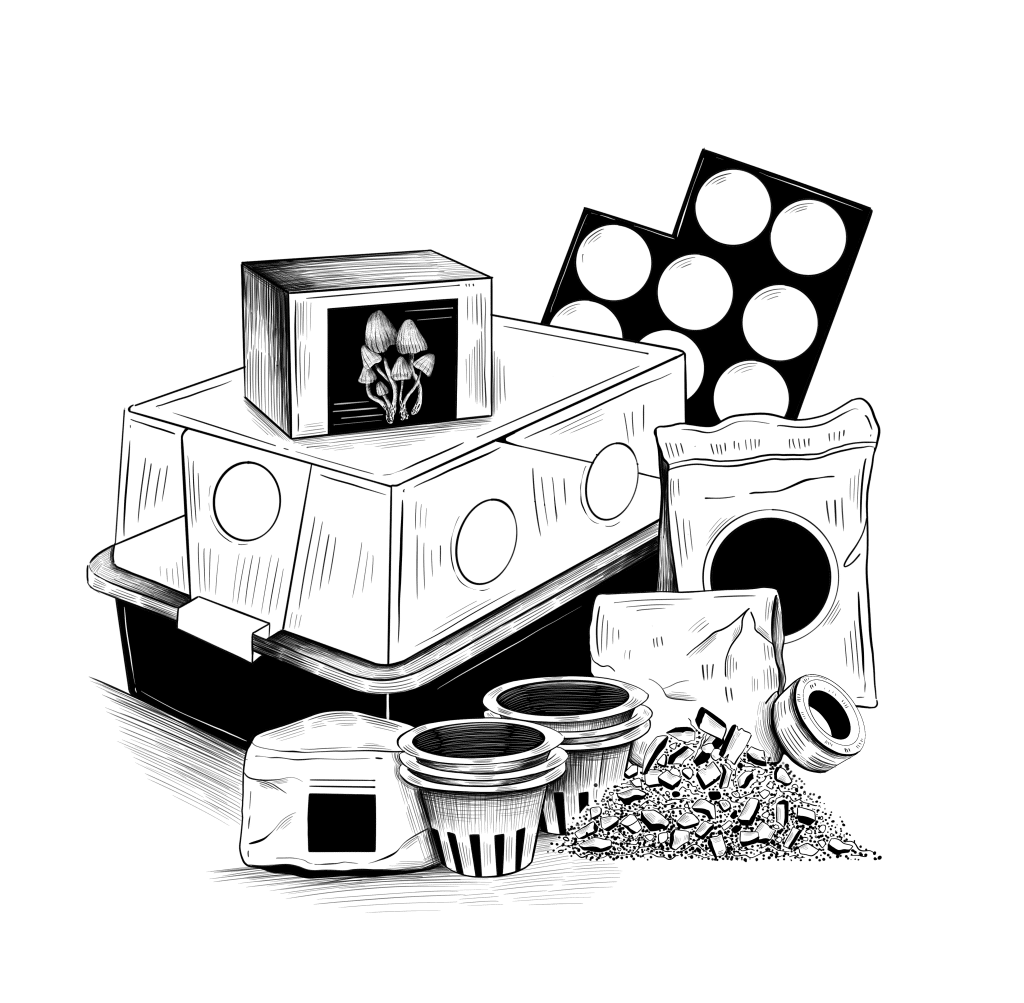
How to Prepare & Store Psilocybe weilii Mushrooms
Whether you’ve picked a bunch of Psilocybe weilii mushrooms from the wild or successfully cultivated them at home, you’ll need to prepare and store them correctly if you want them to last.
Fresh Psilocybe weilii mushrooms will last for around a week if stored in paper bags and left in the coolest part of a refrigerator. If you want the shrooms to last longer than this, they’ll need preserving.
The best way to preserve magic mushrooms is to dry them. They can be dried by simply placing them on a sheet of grease-proof paper in a well-ventilated area. Air drying will take two to three days, but a faster and more efficient way is to use a food dehydrator.
They’ll quickly lose their moisture by spreading the mushrooms evenly on the racks inside the dehydrator and running it at its lowest temperature for 12 to 24 hours. The shrooms are dry enough for storage when they audibly “crack” when snapped in half.
After drying, place the mushrooms inside glass mason jars with a few packets of a food-safe desiccant such as silica gel. The desiccant will eliminate any remaining moisture in the shrooms — ensuring the dried shrooms stay fresh.
Leave the jars in a cool, dark place out of direct sunlight. When stored in this way, the mushrooms will last for several years. However, they’ll begin to lose potency the longer they are stored.
Tips For Consuming Psilocybe weilii Mushrooms
Psilocybe weilii mushrooms can be consumed in the same way as other magic mushrooms. They are far from gourmet mushrooms in terms of flavor and can give you a bit of stomach comfort after consumption. However, they’re perfectly fine to eat raw — fresh or dried.
Due to the intense, earthy flavors of magic mushrooms and the digestive discomfort they can cause, some people like to prepare them before consumption.
Here are a few popular methods of consumption for P. weilii mushrooms:
1. Eating the Mushrooms Whole
Of course, eating Psilocybe weilii mushrooms whole is the quickest way to consume them without putting any preparation effort in. The mushrooms can be chewed whole, fresh, or dried before swallowing with water. They don’t taste great, but if you can get over the flavor, this is a good way to consume psychedelic mushrooms of any kind.
You can speed up the onset time and decrease stomach discomfort by grinding the mushrooms and soaking them in lemon juice.
The acid in freshly squeezed lemon juice begins to break down the mushrooms’ chitin (cell walls) and metabolize the psilocybin into its active metabolite, psilocin. This means less work for your digestive system and a faster onset of effects. This preparation technique is known as Lemon Tek.
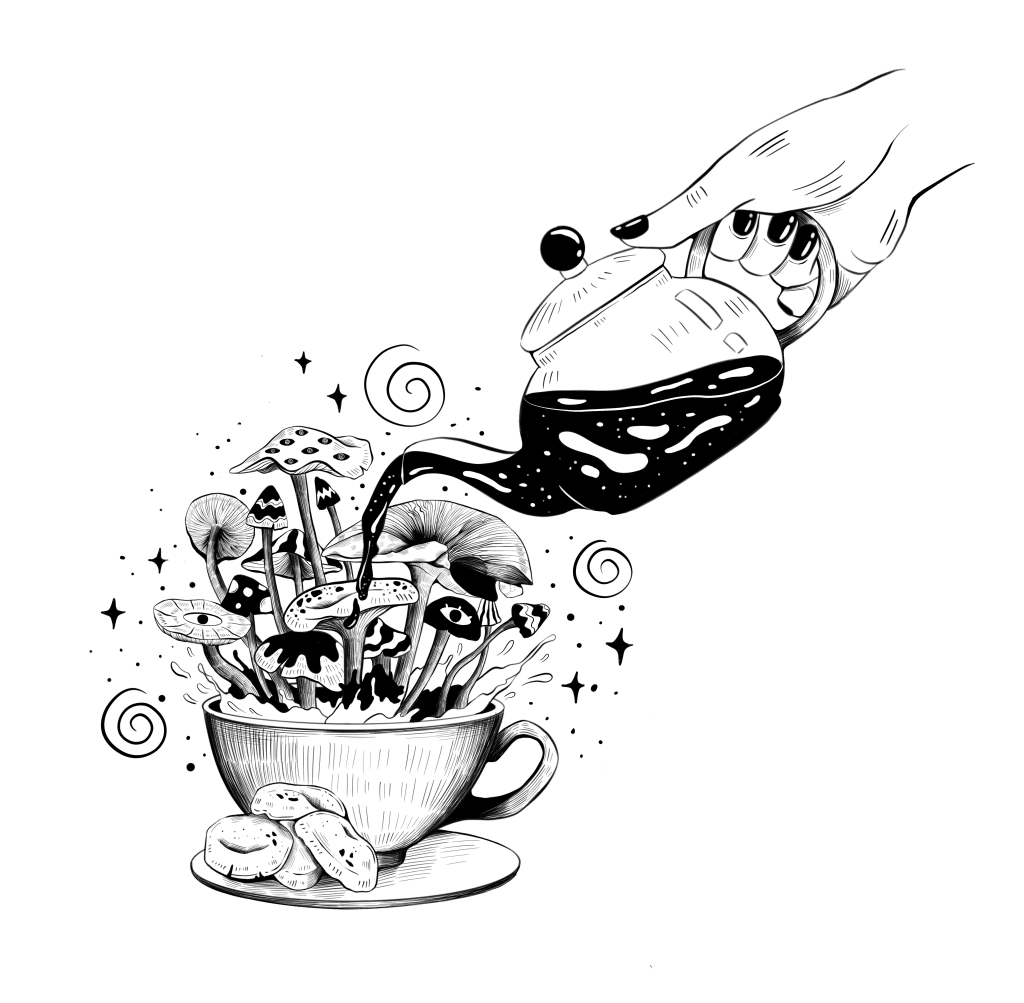
2. Making Magic Mushroom Tea
Magic mushroom tea is a fantastic way to consume Psilocybe weilii or any other magic mushroom species. Tea eliminates the need to consume any organic matter, meaning less stomach discomfort and a significantly faster onset of effects.
Making magic mushroom tea from P. weilii mushrooms is a simple process. First, weigh out a dose of dried shrooms and grind them. Then, combine with hot water in a thermal flask and leave to brew for 20-60 minutes. Once brewed, strain the organic matter and drink the liquid.
Use lemon juice to disguise the taste and improve extraction. Herbal tea blends can also be added to the brew to mask the flavor further.
Learn how to make magic mushroom tea: How to Make Shroom Tea: Step-by-Step Guide
3. Making Psilocybe weilii Capsules
Psilocybe weilii can be used for microdosing. Capsules are popular among people who want to microdose magic mushrooms because they provide a discrete, tasteless, and convenient way to consume them.
Making microdose capsules from dried Psilocybe weilii mushrooms is simple. Grind the mushrooms to a fine powder before filling empty pill capsules with the appropriate dosage. The capsules can then be stored in child-proof containers with a food-safe desiccant to eliminate any moisture inside the container.
Keep the capsules in a cool, dark place during storage to maintain their effectiveness.
4. Making Psilocybin Edibles
Magic mushrooms of any kind aren’t particularly enjoyable to eat. They taste earthy and often cheesy — in a bad way. Making psilocybin edibles is a great way to mask the strong taste of Psilocybe weilii shrooms and make the consumption process much more enjoyable.
There are several ways to make magic mushroom edibles.
Gummies and chocolates are the most popular edibles to make:
- For psilocybin gummies: How to Make Magic Mushroom Gummies: An Easy Vegan Recipe.
- For psilocybin chocolate: How to Make Magic Mushroom Chocolate: 4 Simple Recipes.
“Magic food” doesn’t end at confectioneries. It’s possible to make a variety of trippy cuisines from shrooms. Provided the mushrooms are cooked at a low temperature for a short time, they can be turned into pretty much anything. Pizza, pasta, brownies, and smoothies are popular among culinary psychonauts.
Check out this article for inspiration on magic mushroom edibles: Trippy Cuisine: Learn How to Cook With Magic Mushrooms.
Are Psilocybe weilii Mushrooms Legal?
Psilocybe weilii mushrooms can be collected from the wild and cultivated at home easily. However, they may not be legal to pick, grow, possess, and consume in your region.
Although research into the potential benefits of psilocybin is increasing, it remains a restricted substance in most places across the globe, meaning magic mushrooms such as Psilocybe weilii are illegal in most countries.
Getting caught in possession of Psilocybe weilii mushrooms or any other psilocybin-containing mushroom or product can land you in some serious trouble in the United States, the United Kingdom, and most of Europe. However, there are a few exceptions.
Certain countries don’t enforce their laws surrounding psychedelics, and some European countries and US states have legalized or decriminalized psilocybin.
Let’s take a look at where Psilocybe weilii shrooms are legal or unrestricted:
Canada
Canada is a bizarre country in terms of psychedelic substance legislation. Psilocybin is still very illegal in Canada. The production, sale, possession, and consumption of psilocybin is restricted. However, there are magic mushroom dispensaries everywhere — both on the street and online. So, why is this?
The laws surrounding psilocybin in Canada are somewhat unenforced. Psychedelic substances aren’t a priority to the Canadian police, and other than a raid on a psychedelic dispensary here and there, people are free to sell, possess, and consume magic mushrooms (seemingly) without the fear of consequences.
Buying magic mushrooms in Canada is incredibly easy and stress-free. They can be ordered online with guaranteed (yes, guaranteed) postage direct to your door. Alternatively, psychonauts can buy shrooms from one of the many magic mushroom stores dotted across the country.
What’s happening with magic mushrooms in Canada is exactly what happened before cannabis was legalized in 2018. Before then, several physical and online weed dispensaries operated illegally.
We expect that magic mushrooms will follow a similar direction to cannabis in Canada. Over the coming years, magic mushroom dispensaries will undoubtedly operate illegally until, eventually, the government has no choice but to change the laws.
The United States
In the United States, psilocybin is illegal on a federal level. However, like in Canada, psilocybin seems to be following a similar route to cannabis in the US.
Cannabis is still federally illegal in the United States, but more than 24 states have legalized the substance under local legislation. The same is true with psilocybin. Although the psychedelic alkaloid remains federally illegal, some states are adjusting their legislation.
Seven US states have altered their psilocybin legislation, making the substance legal for medical or recreational use or decriminalizing it. There’s still a long way to go in the US until magic mushrooms are treated like cannabis. Some states have only changed their laws minutely, and others have only legalized psilocybin in certain municipalities.
With that said, these US states have altered their psilocybin laws:
We can expect magic mushrooms to follow a similar route to cannabis in the United States. Although we’re still a long way off from full federal legalization of psilocybin (and even cannabis), the number of states that legalize psilocybin will undoubtedly grow over the coming years.
Europe
Psilocybin is still a controlled substance in most European countries. However, a few countries have legalized or decriminalized psilocybin in certain forms.
In the Netherlands, magic mushroom sales became illegal in 2008. However, a loophole in the law means that “magic truffles” — psilocybin-producing sclerotia — can be sold, possessed, and consumed legally.
Magic truffles such as “Philosopher’s Stones” from the species Psilocybe tampanensis and “Flesh of the Gods Truffles” from Psilocybe mexicana can be purchased from a variety of physical and online “Smart Shops.” Although Psilocybe weilii mushrooms aren’t legal in the Netherlands, it’s possible to consume psilocybin in the form of sclerotia.
Portugal has decriminalized the use of all drugs. Psilocybin and magic mushrooms can be possessed and consumed without fear of prosecution in the country. However, selling psilocybin-containing fungi and edibles is restricted, so obtaining magic mushrooms can be difficult.
In Austria, psilocybin-containing mushrooms and sclerotia have been decriminalized for research purposes. Psilocybe weilii and other psilocybin-producing fungi can be cultivated and studied as long as “they aren’t used as a drug.”
Unfortunately for those living outside of these countries, magic mushrooms are probably illegal. However, their spores are legal in 99% of European countries. This means you can buy them legally by purchasing them online. Just remember that as soon as they’re germinated, they become illegal.
Frequently Asked Questions
Here are answers to a few frequently asked questions about shrooms.
1. What is a Mushroom Strain, & How is it Different from a Species?
You may have heard the term “strain” used when describing magic mushrooms. Strains, like species, are often visually distinct. However, strains — although genetically distinct — belong to an individual species.
For example, a single species such as Psilocybe cubensis can be made up of hundreds of different strains, many with distinct differences in physical and chemical characteristics. Some strains produce high levels of psilocybin, such as Penis Envy; some produce low levels of psilocybin, such as Hillbilly; others produce utterly bizarre-looking mushrooms, such as Enigma.
2. What are Magic Truffles?
Magic truffles are similar to magic mushrooms in that they produce psilocybin. Truffles grow from the same species that produce mushrooms. Not all species produce them, but those that grow in harsh environments, such as Psilocybe mexicana and Psilocybe tampanensis, tend to.
Although called “magic truffles,” they’re actually sclerotia — dense masses of collective mycelium that grow underground.
The purpose of sclerotia is to ensure the species’ survival through periods when the environment isn’t suited for mushroom growth. They allow the species to remain dormant underground, ready for a change in conditions that promote mushroom growth.
Magic truffles are usually less potent than magic mushrooms, producing average psilocybin levels of around 0.80%. They can be grown in a similar way to magic mushrooms, but instead of fruiting the spawn, it’s left for several months in a dark area to form sclerotia.
Magic truffles are popular in the Netherlands, where psilocybin mushrooms are illegal, but psilocybin-producing sclerotia are not. They are available to purchase fresh (dried truffles are illegal) from a variety of different physical and online “Smart Shops.”
3. How Many Magic Mushroom Species Exist?
There are over 180 different mushroom species that produce the psychedelic tryptamines psilocybin and psilocin.
These species differ in shape, size, and potency, with some species producing trace amounts of psilocybin and others producing up to 2%, such as Psilocybe azurescens.
The majority of the “magic mushroom” species belong to the genus Psilocybe. However, some species in the genera Panaeolus, Gymnopilus, Conocybe, and Copelandia also produce psychedelic tryptamines.
Here’s a list of the most common magic mushroom species:
- Psilocybe azurescens
- Psilocybe aztecorum
- Psilocybe cubensis
- Psilocybe caerulescens
- Psilocybe cyanescens
- Psilocybe mexicana
- Psilocybe tampanensis
- Psilocybe weilii
- Psilocybe stuntzii
- Panaeolus cyanescens
- Panaeolus cinctulus
- Panaeolus subbalteatus
- Panaeolus bisporus
- Gymnopilus luteus
- Gymnopilus viridans
- Gymnopilus aeruginosus
- Conocybe siligineoides
- Conocybe cyanopus
4. Can You Grow Magic Mushrooms Outdoors?
Yes, it’s possible to grow magic mushrooms outdoors. However, some species are easier to cultivate than others. If you wish to grow mushrooms outdoors, the climate in your area must be suitable for the growth of the species in question.
A dark, humid environment is necessary to promote the growth of mycelium and later promote fruiting — mushroom production.
Selecting an appropriate growing medium for the species you wish to grow is important. Most species of Psilocybe and Panaeolus can be cultivated on a nutrient-rich substrate that contains a high amount of organic matter. Straw, wood chips, manure, and compost are common.
A growing bed filled with substrate should be prepared and seeded with spores or live spawn that have been colonized with mycelium. The bed can then be left to let nature take its course, and hopefully, when the correct climatic conditions arise, mushrooms will begin to appear.
Growing magic mushrooms can be rewarding and prolific. If successful, the mushroom bed should continue to fruit year after year with very little intervention.
Here are a few easy species to grow outdoors:
- Psilocybe cyanescens
- Panaeolus cyanescens
- Psilocybe cubensis
- Panaeolus cinctulus
- Psilocybe mexicana
- Psilocybe aztecorum
Subscribe For More Psychedelics 🍄
References
- Cavanna, F., Muller, S., de la Fuente, L. A., Zamberlan, F., Palmucci, M., Janeckova, L., … & Tagliazucchi, E. (2022). Microdosing with psilocybin mushrooms: a double-blind placebo-controlled study. Translational Psychiatry, 12(1), 307.

